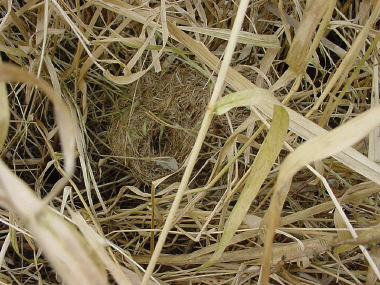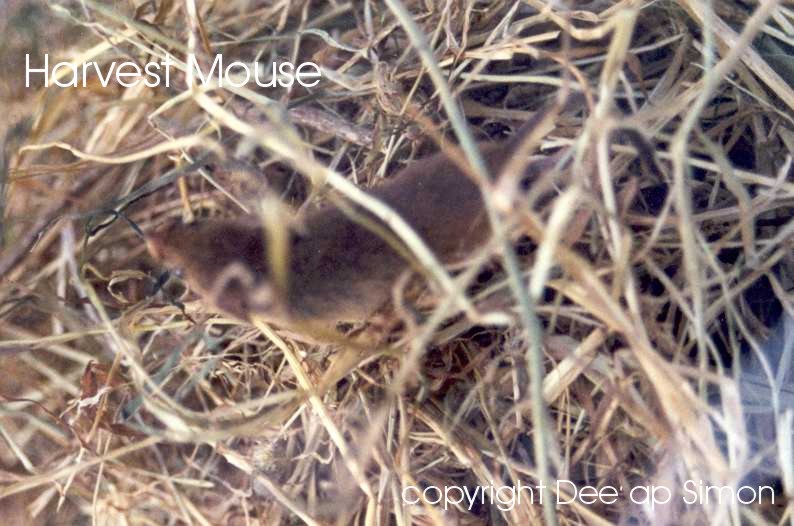HARVEST MOUSE
(MICROMYS MINUTUS)
LOCAL BIODIVERSITY ACTION PLAN
Links
to associated HAPs
None
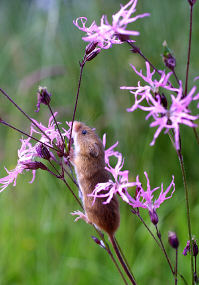 Current
Status
Current
Status
The harvest mouse
was once previously described as common and widespread throughout Britain occupying
a wide range of habitats but favouring areas of tall, dense vegetation. It has
always been more prevalent in southern counties. There is little known about
the natural history, present status and distribution of the harvest mouse in
the UK. The species is considered `Vulnerable` in the UK and `Endangered` and
`Near-Endangered` in many parts of its vast worldwide range. Mitchell Jones
(1996) believed the harvest mouse to be a species declining but widespread in
England. In 1973 Stephen Harris of the Mammal Society carried out a study to
establish the status and distribution of the harvest mouse in Britain and to
collect data on its habitats requirements. In Vice County 58, 13 records of
nests were recorded from 8, 10km grid squares by the end of 1977 (1205 records
in the UK), a further 3, 10km grid squares contained pre-1960 records.
The species can easily
pass undetected and is, therefore, vulnerable to under-recording. In May 1996
the Mammal Society carried out a "Harvest Mouse Tennis Ball" national
survey at 13 sites within the UK with grids of 50 tennis balls. Only one of
the tennis balls was occupied by a harvest mouse during the survey.
Threats
-
Agricultural
practices (intensive farming methods - pesticides, crop rotation)
-
Habitat destruction
- fragmentation, wetland draining
-
Lack of information
and poor species identification - under-recording, and lack of knowledge
of Harvest Mouse ecology
-
Extreme weather
conditions - linked-in with a naturally occurring `boom & bust` ecology,
the added problems of habitat destruction etc listed above focus this issue.
How are
we helping to conserve the Harvest Mice in the Cheshire region?
-
The Mammal
Society has produced preliminary results of its 2-year (1996/7) follow-up
survey of 800 sites where harvest mice were recorded in the 1970's.
-
The Cheshire
Mammal Group are actively involved in the captive breeding programme. Several
members of the Group are carrying out surveys of their local sites, such
as Gateworth and Pickering's Pasture to determine the existence of harvest
mice. Data about other small mammal species is being collected in the process.
-
Data analysis:
On going analysis of trapping records. All records are being sent through
to `rECOrd`.
-
Raising awareness
of this species in Cheshire. Eg. through attendance at Cheshire Mammal Group
Meetings, Cheshire Wildlife Trust`s `Only One Earth` exhibition, talks to
other natural history groups, and through extensive press and television
coverage.
Objectives,
Targets and Actions
OBJECTIVES
|
LOCAL TARGETS
|
| To monitor
and record the status of Harvest Mice in Cheshire. |
To encourage further recording
of this species across the County |
| To ensure accurate species identification
and to verify those records already in existence where this has not already
been achieved. |
| Re-surveying of Cheshire sites where
harvest mice have been historically recorded to determine whether they are
still there, and to extend the sites to be surveyed in Cheshire. |
| To form
a written protocol for use in the re-introduction of Harvest Mice around
the world where and when needed. |
Analyse data obtained
during the 2002, 2003 and 2004 experimental releases. |
| To write-up and
publish the data obtained. |
| IUCN Re-introduction Guidelines
to be followed at all times and any releases must be co-ordinated by the
BAP Action Group. |
| To maintain
an active program of post-release monitoring to determine the survival and
dispersal of this species post-release, and to record existing naturally-occurring
mice. |
Monthly live-mammal
trapping sessions. |
| Further data obtained in future
monitoring of release will be used to refine the planned Re-introduction
Protocol for the species. |
| Spring nest searches. |
| Investigating
habitat preference. |
Vegetation recording to be used
to monitor habitat choice in released animals where possible. |
| Vegetation recording to obtain
habitat choice information for naturally-occurring harvest mice in Cheshire. |
| To
maintain and encourage further links with Agri-environmental schemes eg: |
DEFRA
- through extending the Countryside Stewardship Schemes where Harvest Mice
feature. |
| BASC -
maintain inclusion of Harvest Mice in the `Green Shoots` survey. |
ACTION
REQUIRED
|
|
We will continue to monitor both release sites for a further year –
to encompass all of 2007. |
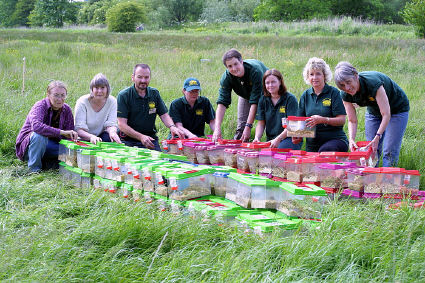 |
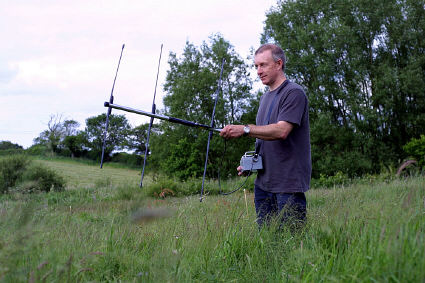 |
Progress
so far
| 2006
Action Completed |
-
A large
team of volunteers continued to monitor the 2002 and 2003 Experimental
Release sites for this species throughout 2006. The monitoring sessions
occurred approximately three time during the year on each of the two
Chester Zoo sites and Harvest mice were found to still be present
in the area four years after the first release. We are aware that
there is the likelihood that the Harvest mice have dispersed into
a much wider area than that currently being monitored but in order
to obtain comparative date over the four year post-release period,
we need to continue to monitor in exactly the same way throughout
this time. All species caught in live-mammal traps during our sessions
are recorded (identified, weighed, sexed and marked where appropriate)
and this data is currently being collated and analysed by Eleanor
Kean.
|
2005 Action
Completed
|
-
The North of England Zoological Society
(NEZS) team and many volunteers, continued to monitor the two 2002
and 2003 release sites on NEZS land throughout 2005. Harvest
Mice were found on both sites during 2004 and also into 2005.
Nest searches were carried out in February and March 2005, and determined
increased numbers of nests on the 2003 release site and over a wider
range of the habitat.
-
Biota and Cheshire County Council
continued to monitor the 2004 release site at Anderton Nature Park
Northwich. The thesis documenting this release and the immediate
post-release monitoring, including the radio-tracking of 20 individuals
for twenty days, was published by John Crowder, as his third year
undergraduate thesis from Liverpool John Moores University.
-
Both the Gatewarth and Pickerings
Pasture release sites were monitored throughout 2004 and 2005, and
the smallest site at Pickerings Pasture reports that no mice were
found and it was presumed that they had disappeared or dispersed into
adjacent habitat.
-
Analysis of data from the releases
is on-going and a three-month contract is underway to write-up the
radio-tracking and trapping reports.
-
Currently, the NEZS, the Cheshire
Wildlife Trust (CWT) and the British Association of Shooting and Conservation
(BASC) are validating, through extensive surveying, the sites identified
as possibly containing harvest mice by the BASC Green Shoots Project
of 2003.
-
Publicity and awareness raising continue
to be major part of this project. Lectures, mice and display
materials were taken to many local and regional events. Harvest
mice and the release protocol were the subject of one section of Manchester
Metropolitan University`s MSc course in Animal Management, Conservation
and Breeding Unit in Spring 2005. Also, harvest mice on the
Zoo`s sites featured in the 2005 `Springwatch` series with Bill Oddie.
-
There was on-going training of volunteers
during the regular live mammal trapping sessions during 2004 and 2005,
and dozens of students benefited from this.
|
2004 Action
Completed
|
-
2004
release at Anderton Nature Park, Northwich. This was carried out following
the protocol established in previous experimental releases:
- extensive small mammal survey work prior to release
- approx. 400 animals released (17& 19 th June) using ‘hard’
and ‘soft’ release techniques
- 20 animals radio tracked for 21 days from release date
- regular post release monitoring
-
Continued
monitoring of 2002 and 2003 release sites throughout 2004.
-
Survey
work initiated in 2004 at several possible Harvest Mouse sites identified
by BASC Green Shoots project.
-
Publicity
and awareness raising in 2004 included mice and display materials
taken to many local and regional events including Wrexham Science
Fair and Chester One World Day and talks given to local and national
groups.
-
The analysis
of data from releases is ongoing.
|
2003 Action
Completed
|
-
100 Harvest
Mice released onto the Gatewarth Site, Warrington in May 2003 in conjunction
with Warrington Borough Council. These mice were bred at the Zoo,
had their veterinary screening undertaken and were micro-chipped by
the Zoo`s veterinary team.
-
270 Harvest
Mice were released onto Zoo land adjacent to the Shropshire Union
Canal in Upton-by-Chester in mid-June 2003. The aim of the project
is to establish a re-introduction protocol for this species, which
can be used world wide as and when required. These mice were released
in a 50:50 sex ratio and a 50:50 `hard` versus `soft` release experiment,
and in addition 20 animals (10 males and 10 females, 10 hard released
and 10 soft released) were radio-collared and tracked for a period
of 20 days, 24 hours per day, post release. This was to determine
survival, dispersal and habitat choice.
-
Extensive
pre-release monitoring, at the release site, through live mammal trapping,
was undertaken in accordance with the IUCN Guidelines for re-introduction.
In addition pre-release veterinary health screening - both of Zoo
mice and the indigenous small mammals in the release area was carried
out by the Zoo`s veterinary team. All mice were micro-chipped for
individual identification prior to release. A vegetation mapping exercise
was carried out prior to release and will continue throughout the
year to assess the habitat. Apart from the radio-tracking, live mammal
trapping began three weeks after the release and this form of post-release
monitoring will continue throughout the year at 4 to 5 weekly intervals.
-
Post-release
monitoring continued in 2003 at and around the two (Zoo and Pickering`s
Pasture) release sites used in 2002.
-
The Harvest
Mouse Project has linked in to information provided by BASC`s species
survey of 2002 and several potential harvest mice locations have yet
to be investigated.
-
Training:
Several interested individuals have been trained in trapping techniques
(20+), nest surveys (10+), radio-tracking techniques (12+) and husbandry
techniques (100+).
-
Partnership
Agreement between major participants in the captive breeding for experimental
release.
|
|
1997-2003
Action Completed
|
- Training for volunteers
in live mammal trapping techniques.
- County-wide 1999-2000 survey
completed.
- Experimental release of
170 harvest mice into 2 sites in Cheshire during 2002.
|
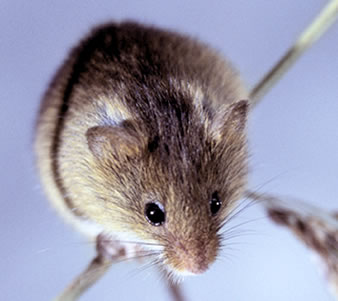 |
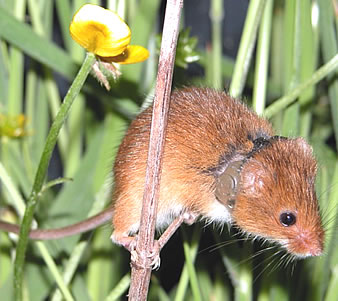 |
How to find
out more about Harvest Mice
BBC Wildfacts website
- www.bbc.co.uk/nature/wildfacts/factfiles/266.shtml
Chester Zoo article 'The
2003 Harvest Mouse Release'
CWT
Harvest Mouse webpage
How can
you get involved?
Anyone wishing to
become involved with live mammal trapping sessions should contact Penny
Rudd, at Chester Zoo on 01244 650215.
Contact
details
|
LBAP Chair |
Penny
Rudd, Chester Zoo
Phone: 01244 650215 |
References
& Glossary
Harris, S. (1979):
History, distribution and habitat requirements of the Harvest Mouse in Britain,
Mammal Review, Volume 9, No. 4, 159-171.
Mitchell-Jones, A.J. (1996): Mammal in England, a conservation action priority
list, English Nature No.26


 Current
Status
Current
Status 